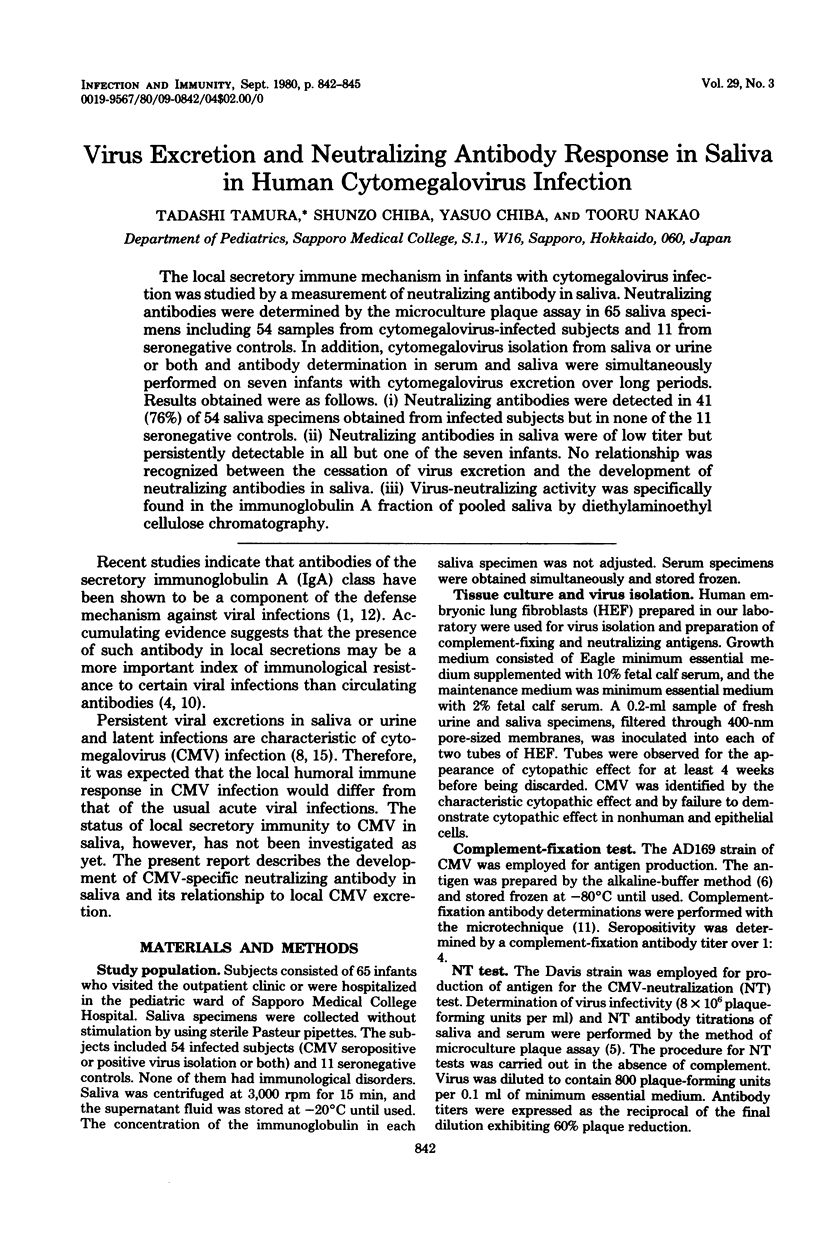Abstract
The local secretory immune mechanism in infants with cytomegalovirus infection was studied by a measurement of neutralizing antibody in saliva. Neutralizing antibodies were determined by the microculture plaque assay in 65 saliva specimens including 54 samples from cytomegalovirus-infected subjects and 11 from seronegative controls. In addition, cytomegalovirus isolation from saliva or urine or both and antibody determination in serum and saliva were simultaneously performed on seven infants with cytomegalovirus excretion over long periods. Results obtained were as follows. (i) Neutralizing antibodies were detected in 41 (76%) of 54 saliva specimens obtained from infected subjects but in none of the 11 seronegative controls. (ii) Neutralizing antibodies in saliva were of low titer but persistently detectable in all but one of the seven infants. No relationship was recognized between the cessation of virus excretion and the development of neutralizing antibodies in saliva. (iii) Virus-neutralizing activity was specifically found in the immunoglobulin A fraction of pooled saliva by diethylaminoethyl cellulose chromatography.
Full text
PDF



Selected References
These references are in PubMed. This may not be the complete list of references from this article.
- Beutner K. R., Morag A., Deibel R., Morag B., Raiken D., Ogra P. L. Strain-specific local and systemic cell-mediated immune responses to cytomegalovirus in humans. Infect Immun. 1978 Apr;20(1):82–87. doi: 10.1128/iai.20.1.82-87.1978. [DOI] [PMC free article] [PubMed] [Google Scholar]
- Brandtzaeg P. Human secretory immunoglobulins. 4. Quantitation of free secretory piece. Acta Pathol Microbiol Scand B Microbiol Immunol. 1971;79(2):189–203. [PubMed] [Google Scholar]
- Cebra J. J., Robbins J. B. Gamma-A-immunoglobulin from rabbit colostrum. J Immunol. 1966 Jul;97(1):12–24. [PubMed] [Google Scholar]
- Chiba S., Striker R. L., Jr, Benyesh-Melnick M. Microculture plaque assay for human and simian cytomegaloviruses. Appl Microbiol. 1972 Apr;23(4):780–783. doi: 10.1128/am.23.4.780-783.1972. [DOI] [PMC free article] [PubMed] [Google Scholar]
- Chiba Y., Horino K., Umetsu M., Wataya Y., Chiba S. Virus excretion and antibody response in saliva in natural mumps. Tohoku J Exp Med. 1973 Nov;111(3):229–238. doi: 10.1620/tjem.111.229. [DOI] [PubMed] [Google Scholar]
- HALLAUER C., KRONAUER G. EXTRACTION OF CELL-ASSOCIATED VIRUS WITHOUT DAMAGE OF THE CULTURE. (BRIEF REPORT). Arch Gesamte Virusforsch. 1965;15:433–440. doi: 10.1007/BF01241771. [DOI] [PubMed] [Google Scholar]
- Ogra P. L., Karzon D. T. The role of immunoglulins in the mechanism of mucosal immunity to virus infection. Pediatr Clin North Am. 1970 May;17(2):385–400. doi: 10.1016/s0031-3955(16)32417-8. [DOI] [PubMed] [Google Scholar]
- SEVER J. L. Application of a microtechnique to viral serological investigations. J Immunol. 1962 Mar;88:320–329. [PubMed] [Google Scholar]
- TOMASI T. B., Jr, TAN E. M., SOLOMON A., PRENDERGAST R. A. CHARACTERISTICS OF AN IMMUNE SYSTEM COMMON TO CERTAIN EXTERNAL SECRETIONS. J Exp Med. 1965 Jan 1;121:101–124. doi: 10.1084/jem.121.1.101. [DOI] [PMC free article] [PubMed] [Google Scholar]
- Waner J. L., Hopkins D. R., Weller T. H., Allred E. N. Cervical excretion cytomegalovirus: correlation with secretory and humoral antibody. J Infect Dis. 1977 Dec;136(6):805–809. doi: 10.1093/infdis/136.6.805. [DOI] [PubMed] [Google Scholar]
- Weller T. H. The cytomegaloviruses: ubiquitous agents with protean clinical manifestations. II. N Engl J Med. 1971 Jul 29;285(5):267–274. doi: 10.1056/NEJM197107292850507. [DOI] [PubMed] [Google Scholar]


